Our Supermicro A2SDi-8C+-HLN4F review combines a familiar platform with a midrange SoC providing an intriguing value. As far as an overall platform, this is going to be a compute and storage-heavy but networking light platform. The Supermicro A2SDi-8C+-HLN4F utilizes 1GbE rather than 10GbE interfaces. The benefit is that by shedding the SFP+ and, more importantly, 10Gbase-T PHYs, the platform will save a significant cost and therefore retail pricing will be lower. Another benefit to using 1GbE networking is lower power consumption.
With $499 street pricing, this is a middle ground in the lineup. There are lower-end platforms that feature lower core count and de-featured SoC’s in the Intel Atom C3000 lineup. Conversely, there are the high-end, but much more expensive platforms based on higher core count Atom chips such as the C3958 and C3955. The Supermicro A2SDi-8C+-HLN4F based on the Intel Atom C3758 8-core CPU is the mid-range option making it applicable to a larger set of applications.
Test Configuration
Here is our basic configuration for this class of CPU:
- Motherboard: Supermicro A2SDi-8C+-HLN4F
- CPU: Intel Atom C3758 (embedded)
- RAM: 4x 16GB DDR4-2400 ECC RDIMMs
- SSD: Intel DC S3710 400GB
- SATADOM: Supermicro 32GB SATADOM
The CPU itself supports up to 256GB of RAM, in a 4x 64GB configuration. For this class of SKU, that is plenty and our most common configurations are 32GB and 64GB in this range of processor.
We also wanted to take a quick second to note to our readers that Supermicro sells the Supermicro A2SDi-8C-HLN4F as well. The extra “+” in the model number denotes that we are testing the active cooling version. If you are installing this motherboard in a platform like the Supermicro SC503 chassis, you will likely want the passively cooled version and instead utilize chassis fans for redundant cooling. Otherwise, the specs are the same for the Supermicro A2SDi-8C-HLN4F so what we have here will be valid for that platform as well.
Supermicro A2SDi-8C+-HLN4F Overview
Measuring 6.7″ x 6.7″ the Supermicro A2SDi-8C+-HLN4F is a compact mITX motherboard. Compared to previous generations, the Supermicro A2SDi-8C+-HLN4F offers a lot of expansion functionality in a very compact space. Supermicro includes both a 24-pin ATX and a DC input as ways to power the motherboard so you can easily choose a case with either a standard PC power supply or an external power brick. That deployment flexibility makes the platform more versatile.
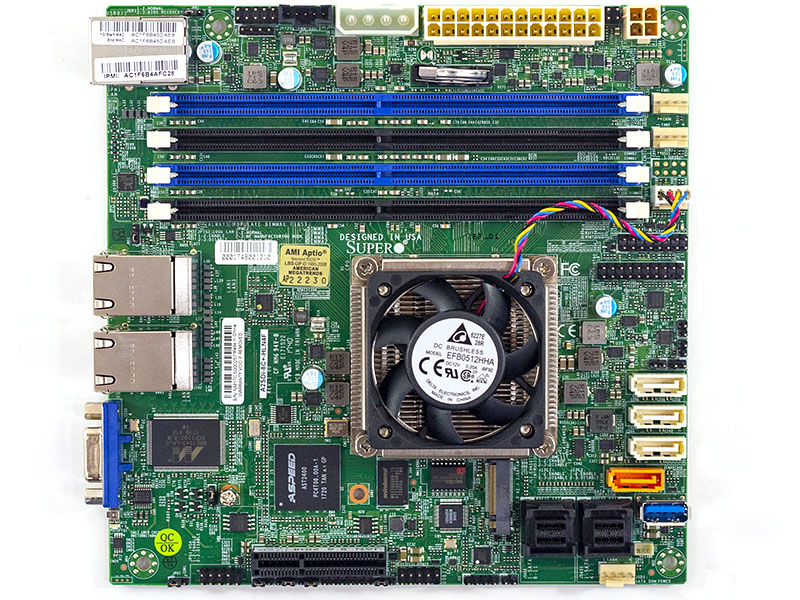
Sporting the Intel Atom C3758 the Supermicro A2SDi-8C+-HLN4F provides a significant upgrade in terms of performance and features compared to the previous generation of Intel Atom C2000 parts. Here is a lscpu output:
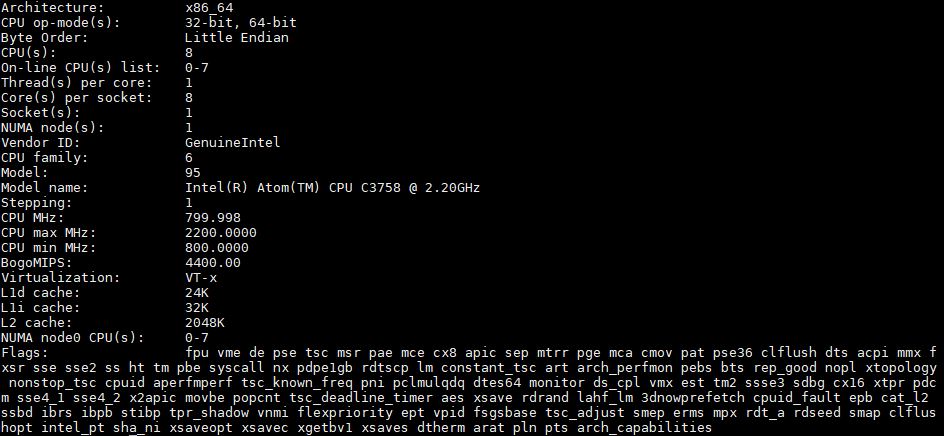
We wanted to highlight two virtualization features. The 8-core Atom is powerful enough for lightweight virtualization so its feature set needs to be more robust than the previous generation. One example of how the new generation excels here is that it supports VT-d for device pass-through.
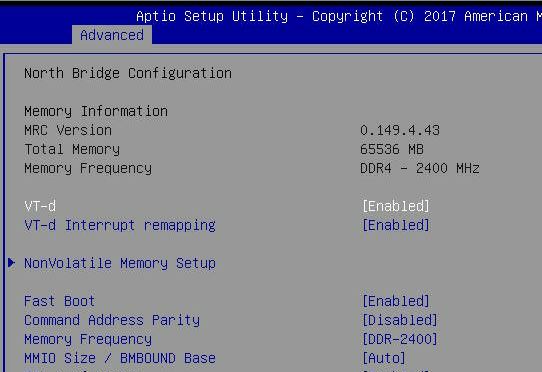
Likewise, there is SR-IOV support with the embedded Atom platform which is an excellent upgrade over previous generations:
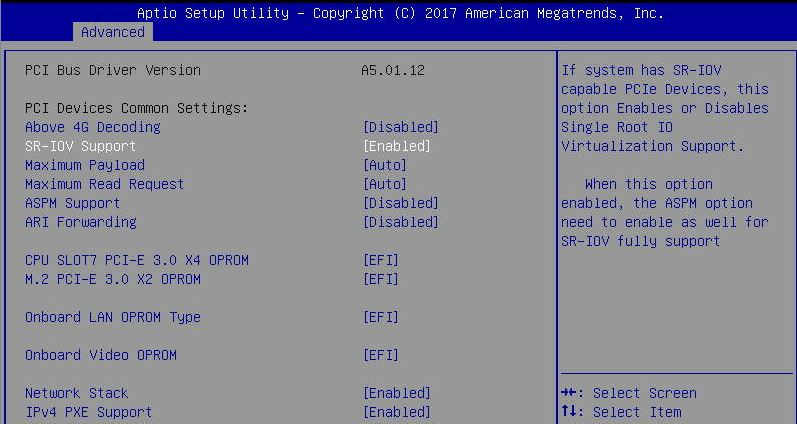
If you are trying to virtualize edge functions or use these systems as Kubernetes endpoints, there are four DDR4 DIMM slots that accept ECC UDIMMs and RDIMMs. We suggest using RDIMMs if possible. With four 32GB ECC RDIMMs, 128GB easily obtainable at reasonable pricing. One can scale the system to 256GB of RAM total using more expensive 64GB DIMMs.
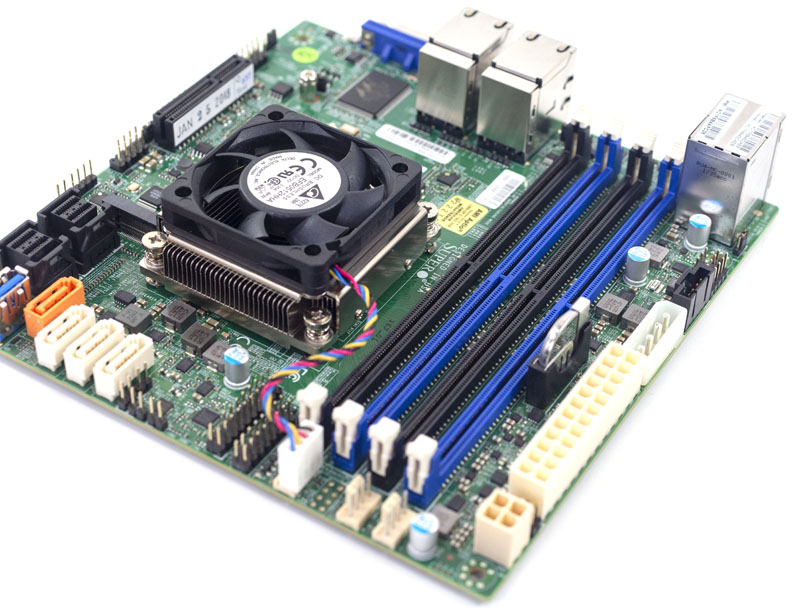
The importance of storage in this platform cannot be understated. Maintaining a low power profile requires integrated SATA III controllers instead of external HBAs. There are two SFF-8643 headers that each can handle 4x SATA III 6.0gbps ports. They do not support SAS drives which makes sense on an embedded platform. Beyond these eight ports, there are four standard 7-pin headers, one is the orange connector Supermicro uses for SATA DOMs with power. Augmenting these 12x SATA III ports is a USB 3.0 Type-A internal header popular for embedded OS installations. One is unlikely to need an additional SAS controller to connect more drives using this platform.
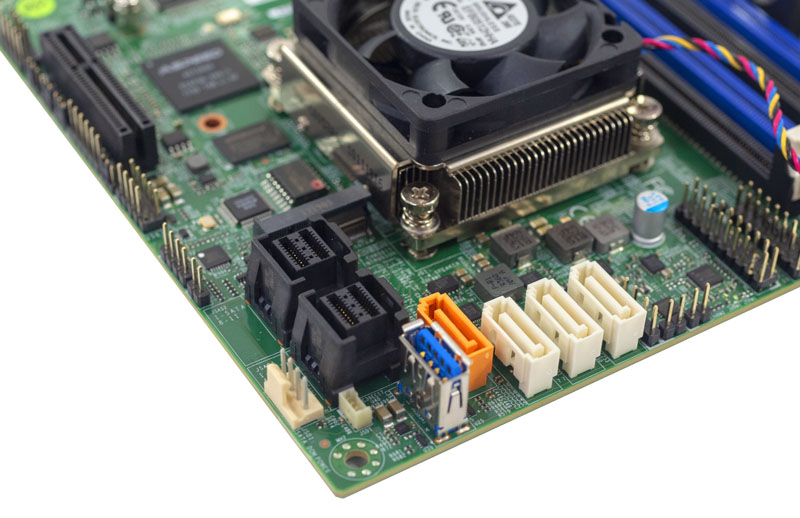
The SFF-8643 ports provide features such as SATA LED so and SGPIO so your enclosure backplanes can correctly display status LEDs. That is important if you are building serviceable appliances and want to have a good end-user experience.
While the SATA ports may be great for boot devices and traditional hard drives, there are new form factors available. For example, M.2 NVMe drives are extremely popular. The Supermicro A2SDi-8C+-HLN4F can handle up to M.2 2280 size SSDs. Along with the PCIe 3.0 x2/ SATA III M.2 slot, there is a PCIe 3.0 x4 slot that is open-ended allowing longer cards to be used.
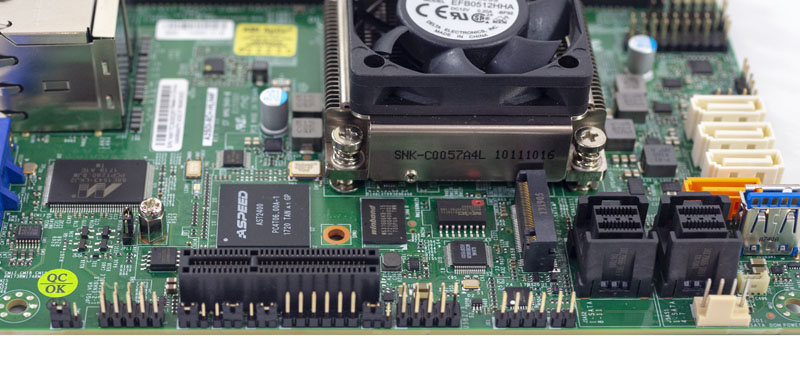
The Supermicro A2SDi-8C+-HLN4F utilizes an active cooler, the SNK-C0057A4L. Supermicro makes a passive version of this platform the Supermicro A2SDi-8C-HLN4F that is the same except that it uses a passive heatsink. These cooling solutions only need to dissipate heat from a 25W TDP Intel Atom C3758 SoC which is relatively easy to do in the context of today’s 200W+ TDP high-end CPUs. The Delta fan is a 4-pin PWM model that can modulate fan speeds alongside cooling requirements.
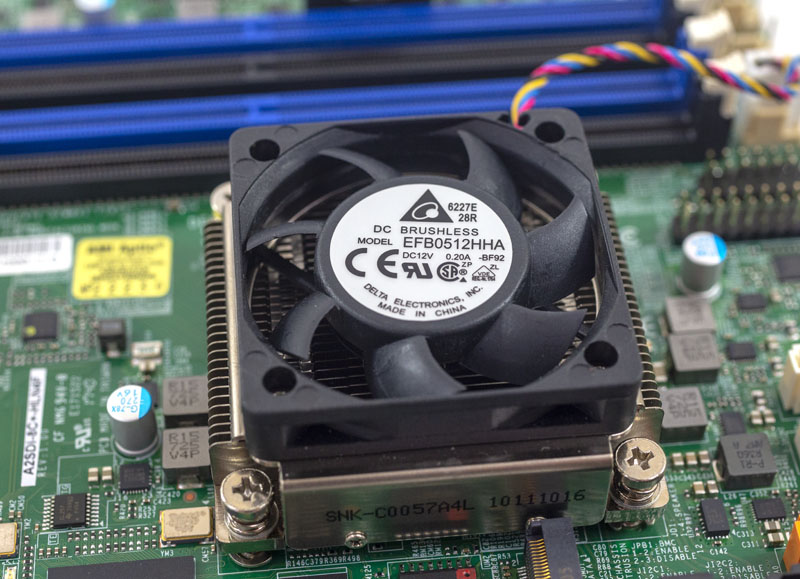
On the left side of the rear I/O panel there is an out of band management NIC port along with two USB ports for external connectivity.
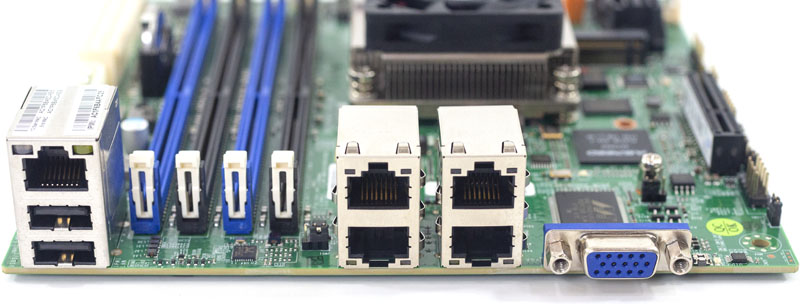
In terms of I/O there are four 1GbE data ports. The PHY for these is the Marvell IC pictured behind the VGA port. That IC may look familiar to many as it has been common on embedded platforms for some time.
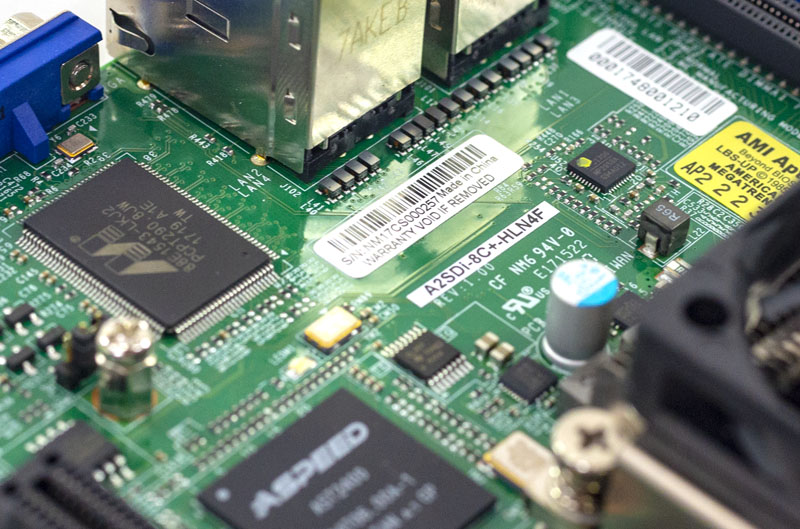
In the OS, the NICs aboard the A2SDi-8C+-HLN4F will use the Intel X553 ixgbe driver, not a Marvell driver. Here, the Marvell chip is being used as a quad-core PHY. You can see our Ubuntu installation sees the NICs as the Intel X553.
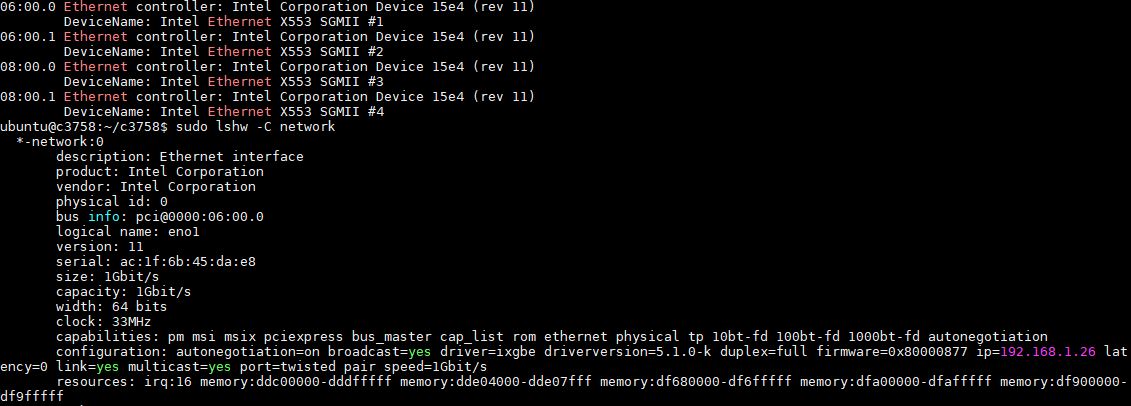
Next, were are going to look at the Supermicro A2SDi-8C+-HLN4F management and system topology. We will then show performance figures along with power consumption and our final thoughts.

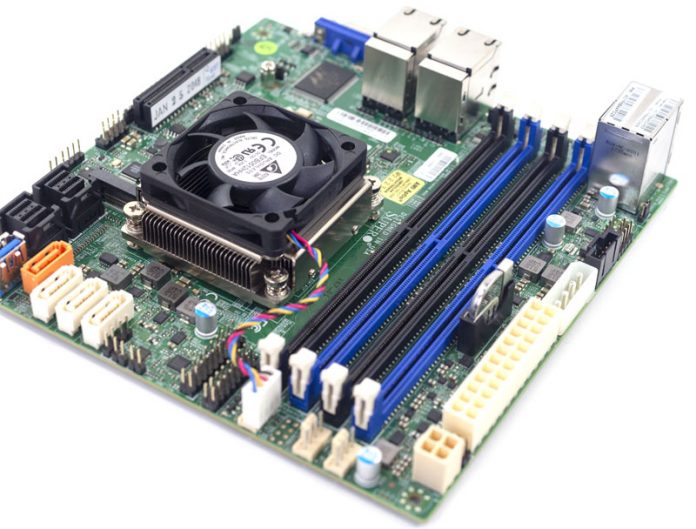



How does this compare to the Epyc 3000 series on a performance/$ aspect?
Thanks for mentioning the H-TF (10GbE) version. I guess there wasn’t room for a couple 1GbE too. But only ~$100 more for 10GbE doesn’t seem so bad (per Amazon).
This one is nice, since it has the 2x 8643 headers. One PciE slot… I’d have to decide between a M.2 sled or 10GbE… though I wouldn’t get many M.2 drives, most likely just one extra :(
Interesting little product. I like the twin SFF 8643 ports. I would like to see them progress to PCIe 4 becuase there are time when using two RAID 10 Vols on a Areca 12G 1883ix-24 that I will saturate the 12G bandwidth.
Park they can’t just progress. It’s limited by the Intel chip. No Intel chips have PCIe4 to this day
Any idea if the C2000 bug still existing on this new platform? I am considering about this but worry about C2000 bug still “carry out” to C3000 platform.
I own this board and I’m not able to reach 14W in idle. My result is 21W with only IPMI connected, one SATA SSD and one RAM module, so I contacted Supermicro and this is their answer:
“we do not have figures for the 8C model but we do have them for 12C model which is also 25W TDP.
The idle consumption was 26.19W, your result of 21W seems normal to us.
We do not know how serverthehome got those figures.”
So how do you meassured 14W? I’m very disappointed about the idle power consumption because the predecessor had a similar low consumption and now its much more (for a Mini ITX project).
Could you provide a bit more information as to how you test power consumption? You specify the measuring device, but not the PSU used (its efficiency obviously affects the test), and any connected peripherals.
Where to buy it?